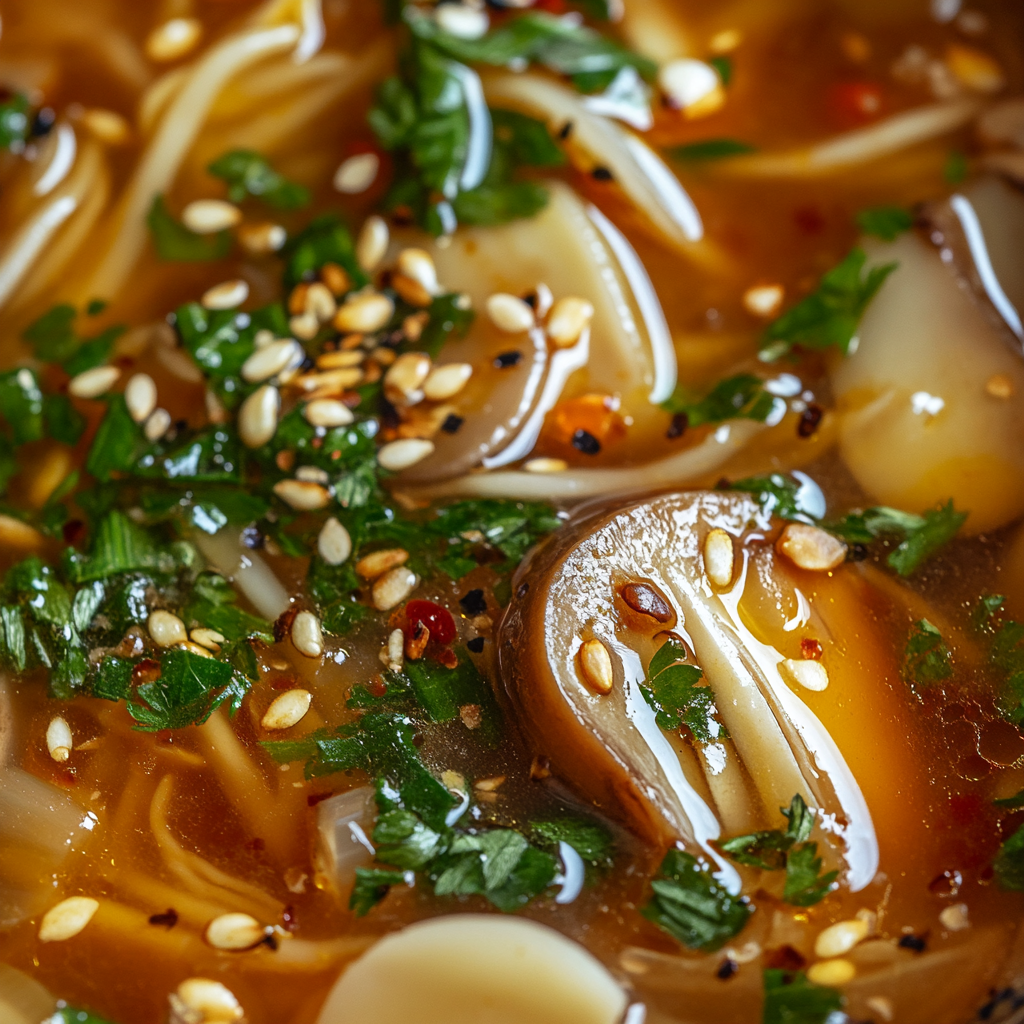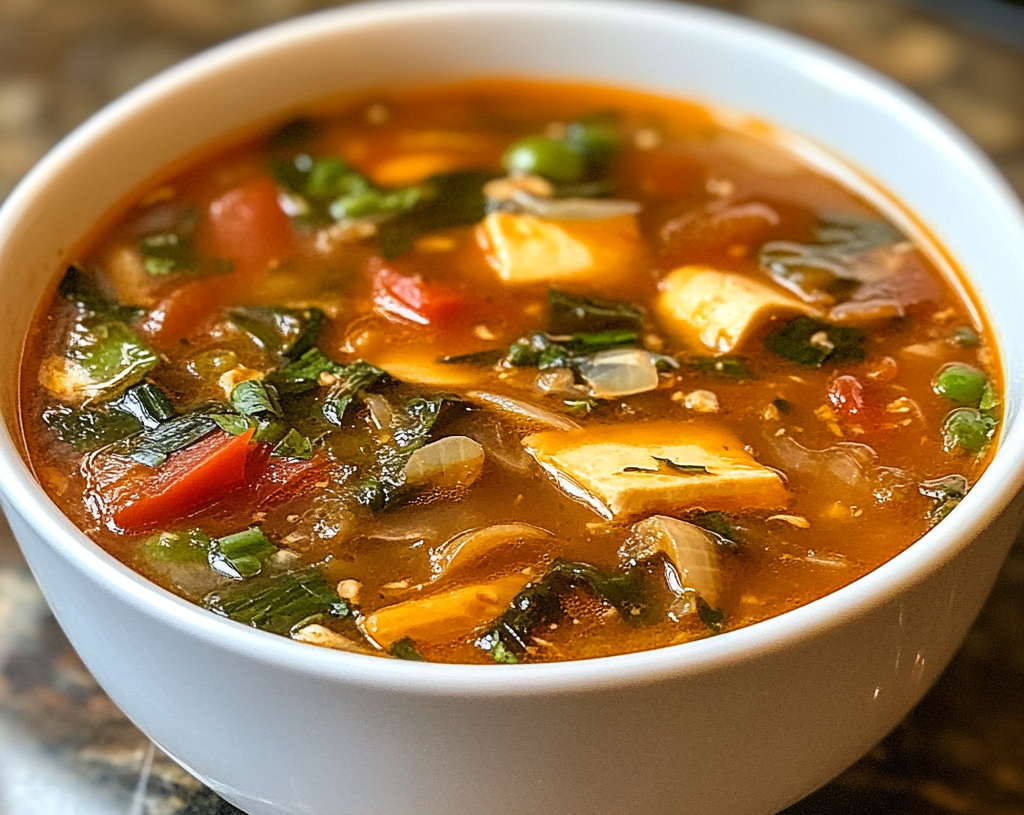Hot and Sour Soup Recipe
Hot and Sour Soup is a classic dish in Chinese cuisine known for its harmonious balance of spiciness and tanginess. Packed with mushrooms, tofu, bamboo shoots, and seasoned with soy sauce, vinegar, and pepper, this soup is comforting, nutritious, and full of robust flavors. It’s the perfect way to start a meal or enjoy as a warming main course on a cool day.
Introduction
Originating from the Sichuan province of China, Hot and Sour Soup has gained popularity worldwide for its dynamic taste and hearty ingredients. Unlike typical clear broths, this soup boasts a rich, slightly thickened texture that pairs well with the bold flavors of soy sauce, vinegar, and a kick of white pepper. This step-by-step guide will help you create an authentic bowl of Hot and Sour Soup in the comfort of your own kitchen.
Ingredients
For the Soup:
- 4 cups chicken or vegetable broth
- 1/2 cup shiitake mushrooms, sliced (dried or fresh)
- 1/2 cup bamboo shoots, julienned
- 1/2 cup firm tofu, cut into thin strips
- 2 tablespoons soy sauce
- 1 tablespoon rice vinegar or black vinegar (adjust to taste)
- 1 tablespoon cornstarch mixed with 2 tablespoons water (for thickening)
- 1 teaspoon white pepper (or to taste)
- 1/2 teaspoon chili oil or Sriracha (optional for heat)
- 1 egg, beaten
For Garnish:
- 2 green onions, finely sliced
- Fresh cilantro (optional)
- A few drops of sesame oil

Step-by-Step Instructions
Step 1: Prepare the Mushrooms
- Rehydrate (if using dried mushrooms): Soak the dried shiitake mushrooms in warm water for 20-30 minutes or until they soften. Drain and slice thinly. If using fresh mushrooms, skip this step and slice directly.
- Reserve Mushroom Water: If you like, save the soaking water and strain it to use as part of the broth for extra flavor.
Step 2: Start the Soup Base
- Simmer the Broth: In a large pot, bring the chicken or vegetable broth to a gentle boil over medium heat.
- Add Soy Sauce and Vinegar: Stir in the soy sauce and rice or black vinegar, adjusting the amount of vinegar according to your desired level of sourness.
- Add Vegetables: Add the sliced mushrooms, bamboo shoots, and tofu strips to the pot. Let them simmer for about 5 minutes.
Step 3: Thicken the Soup
- Create a Slurry: Mix the cornstarch and water in a small bowl until smooth.
- Add to Soup: Slowly pour the cornstarch slurry into the simmering soup while stirring continuously. The soup should begin to thicken slightly.
Step 4: Add Spice and Heat
- Season with Pepper: Stir in the white pepper, adjusting for your heat preference.
- Optional Spice: For an extra kick, add a few drops of chili oil or Sriracha to taste.
Step 5: Add the Egg
- Create Egg Ribbons: Reduce the heat to low and gently drizzle the beaten egg into the soup in a thin stream while stirring slowly. This will create delicate egg ribbons throughout the soup.
Step 6: Final Touches and Garnish
- Adjust Seasoning: Taste and adjust seasoning with more soy sauce, vinegar, or white pepper as needed.
- Add Garnish: Sprinkle sliced green onions, cilantro, and a few drops of sesame oil for aroma and flavor.

Serving and Storage Tips
- Serving: Serve the soup hot in bowls, garnished with fresh green onions and cilantro if desired.
- Storage: Leftovers can be stored in an airtight container in the refrigerator for up to 3 days. Reheat gently on the stovetop to maintain texture.
- Freezing: This soup can be frozen, but the tofu may change in texture slightly upon thawing. Freeze without the egg for best results, adding it fresh when reheating.
Helpful Notes
- Black Vinegar: For a more authentic flavor, try using Chinese black vinegar. Rice vinegar is a great substitute if it’s not available.
- Protein Options: You can add cooked chicken or shrimp to the soup for additional protein.
- Vegetarian Version: Use vegetable broth and ensure your soy sauce is vegan-friendly.
Tips from Well-Known Chefs
- Martin Yan: “When adding egg to the soup, stir slowly in one direction to create long, silky ribbons.”
- Ming Tsai: “Balance is key — the soup should be both spicy and sour, but not overwhelmingly so. Adjust the vinegar and pepper to your taste gradually.”
- Ken Hom: “A drop of sesame oil at the end brings depth and a lovely fragrance to the dish.”
Frequently Asked Questions
1. What can I use instead of tofu?
You can substitute tofu with cooked chicken, shrimp, or even thinly sliced pork.
2. How do I make this soup spicier?
Increase the amount of white pepper or add more chili oil/Sriracha.
3. Can I use other types of mushrooms?
Yes, wood ear mushrooms or button mushrooms work well if shiitake isn’t available.
4. Is it okay to skip the egg?
Yes, the egg adds texture but can be omitted for a vegan version.
5. Why isn’t my soup thick enough?
Ensure your cornstarch slurry is mixed thoroughly before adding it. You may need to add a bit more slurry if you desire a thicker consistency.
6. Can I use apple cider vinegar instead of rice vinegar?
Yes, but it will change the flavor profile slightly. Use sparingly and adjust to taste.
7. What’s the best way to make the soup less salty?
Use low-sodium soy sauce and reduce the amount added initially. You can always adjust to taste after simmering.
8. Can I add noodles to this soup?
Yes, thin rice noodles or glass noodles pair well with Hot and Sour Soup for a more filling meal.
9. Is this soup keto-friendly?
Substitute cornstarch with xanthan gum for thickening and ensure other ingredients fit your dietary plan.
10. Can I make it gluten-free?
Yes, use gluten-free soy sauce and verify that all other ingredients are gluten-free.
Enjoy your Hot and Sour Soup with its perfectly balanced flavors of spice and tanginess — a comforting dish that’s sure to satisfy!
